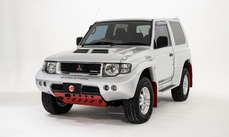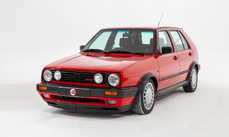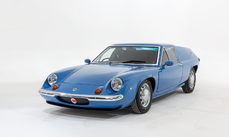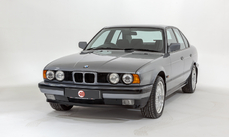Mitsubishi Pajero Evolution 1997
General description :
Model History
The Mitsubishi Pajero, known as the Shogun in the UK, is a Sport Utility Vehicle that first launched in 1982. With roots tracing back to the 1934 PX33 prototype, the first generation of Pajero was unveiled at the Tokyo Motor Show in 1981; the fourth generation is still in production today. Modified versions of the Pajero are noted for having won the Dakar Rally 15 times.
A redesigned second generation Pajero debuted in January 1991. Just about everything was new and further enhanced. It also saw the introduction of Super Select 4WD (SS4), multimode ABS, and electronic shock absorbers. SS4 was groundbreaking in the sense that it combined the advantages of part-time and full-time four-wheel drive with four available options: 2H (high-range rear-wheel drive), 4H (high-range full-time four-wheel drive), 4HLc (high-range four-wheel drive with locked centre differential) and 4LLc (low-range four-wheel drive with locked centre differential). Another advantage of this second generation system is that it gave the driver the ability to switch between two-wheel drive and full-time four-wheel drive at speeds up to 62 mph. Multimode ABS was equally innovative. This meant that the ABS would be fully functional in all modes of SS4, as braking with a locked centre differential requires completely different braking parameters.
The Pajero Evolution was introduced in October 1997 and was developed in response to new entry requirements for the Dakar Rally's T2 Class. The Evolution came standard with a 3.5-litre 24-valve DOHC V6 that featured Mitsubishi Innovative Valve Timing and Electronic Lift Control system (MIVEC). A new dual plenum variable intake helped increase power, and a new independent rear suspension made the ride even smoother. A grand total of 2,500 were manufactured for homologation purposes. They could be ordered in either Sofia White, Passion Red, or metallic Satellite Silver.
Mitsubishi not only dominated the T2 class with this car, they dominated the whole Dakar Rally. Paj-Evos took the top three spots in 1998, beating even the supposedly faster T3 class cars. They covered over 10,000km in 18 days, and finished five hours before the next competitor. Pajeros have won nearly half of all the Dakar Rallies with 15 wins overall.
Equipment
Satellite Silver Metallic paintwork, Recaro cloth upholstery, INVECS-II five-speed automatic transmission with Sports mode, Super Select 4WD system, Rear spoiler with side airdams, Aluminium skid plate, Jaos mud flaps, Four-wheel independent suspension (ARMIE), Privacy glass, Automatic air conditioning, Leather-trimmed steering wheel, Carbon-effect trim, Carbon shift knobs, Electrically adjustable door mirrors, Colour-coded door mirror casings, Passenger side wing mirror, ABS, Wind deflectors, Front SRS airbags, Sony CD player with Bluetooth, Spare wheel, Toolkit, Spare key.
Exterior
The Satellite Silver paintwork remains in great original condition, presenting well with only a handful of minor blemishes to report, the worst being some very light marks in one or two discreet areas. Elsewhere, commonly worn items such as the side steps retain a smart black sheen with no damage or fading to note. The Jaos competition-style mudflaps really add to the sense of occasion, and the rear privacy glass is a welcome addition. Genuine Mitsubishi wind deflectors are also fitted. Furthermore, having resided on the salt-free roads of Japan up until recently, both the body and underside of this rare Pajero remain in remarkable rust-free condition.
Interior
Equipped with attractive Recaro seats the interior of the PajEvo has a rugged but purposeful aesthetic. The seats are upholstered in hardwearing cloth that also extends to the door cards. The steering wheel is trimmed in leather and the dash fascia is finished with carbon-effect trim. The rear seats are also in very good order and boast individual folding armrests; the seats fold forward twice for a huge rear load space. The boot carpet is entirely unmarked and in the rear door you’ll still find the original toolkit.
ENGINE & TRANSMISSION
The Evo is powered by the 6G74 3.5-litre V6. The 24-valve DOHC engine features Mitsubishi’s Innovative Valve Timing and Electronic Lift Control, which varies the timing of the intake and exhaust camshafts to increase the power and torque output over a broad engine speed range.
The engine bay of this example maintains a particularly fresh appearance with no signs of any damage or poor repair. The car pulls well on test and shifts smoothly through each of the five gears. The Super Select 4WD system also operates just as it should, combining the advantages of part-time and full-time four-wheel drive with four additional drive options. The last service was carried out just a few hundred miles ago and following a recent inspection the car boasts a clean bill of health.
WHEELS, TYRES & BRAKES
The original six-spoke alloys have been freshly refurbished to an amazing standard by Lepsons. All five present with an impeccable diamond cut finish, as per original spec. The Mitsubishi centre caps are all present and correct and the wheels are shod in a matching set of rugged Bridgestone all-terrain tyres, really filling those vast box arches. On test the brakes operate well, pulling the Evo to a halt quickly and in a straight line.
History File
This example is one of just 2,500 Evolutions built to homologate Mitsubishi’s Dakar Rally T2-class Pajero. It was first registered in December 1997, remaining in Japan until its recent UK import last year. The car is accompanied by the original owner’s manual, maintenance booklet, and spare key. It has been serviced at the following mileages: 1k, 15k, 19k, 20k, 20k, 20k, and most recently at 34k miles. The car will be sold with 12 months MOT upon sale for the new keeper’s piece of mind.
http://www.4starclassics.com/for-sale/mitsubishi-pajero-evolution-for-sale-2/
1997 Mitsubishi Pajero Evolution is listed sold on ClassicDigest in Kingsley by 4 Star Classics for £18495.
Car Facts
Car type : Car Make : Mitsubishi Model : Pajero Model Version : Evolution Engine size : 3.5 Model Year : 1997 Sub type : Pick up Location : Hampshire
Sold
Seller Information
Sold
People who viewed this Mitsubishi Pajero also viewed similar Mitsubishi listed at ClassicDigest
Other cars listed for sale by this dealer
About Mitsubishi
Mitsubishi: A Journey Through History (Up to the 1980s)**1. Early Beginnings:
Foundation: Mitsubishi's roots trace back to the establishment of a shipping firm by Yataro Iwasaki in 1870.
Diversification: The company expanded into coal mining, shipbuilding, and other industries, forming the basis for the Mitsubishi Group.
**2. Automotive Ventures Begin:
Initial Automobile Production: Mitsubishi ventured into automobile manufacturing in the early 20th century.
Model-A: In 1917, Mitsubishi introduced its first production car, the Model-A, Japan's first series-production automobile.
**3. Post-War Era:
Restructuring: Following World War II, Mitsubishi faced challenges but underwent restructuring and resumed automobile production.
Jeep Production: Initially focused on producing Jeeps, Mitsubishi made significant contributions to Japan's automotive recovery.
**4. Milestone Models:
Mitsubishi 500: Introduced in 1960, the Mitsubishi 500 was a compact car that played a role in popularizing smaller vehicles in Japan.
Mitsubishi Colt 600: Released in 1962, the Colt 600 was a subcompact car contributing to Mitsubishi's expansion in the automotive market.
**5. Global Expansion and the 1970s:
Partnerships: Mitsubishi forged partnerships with international automakers, expanding its reach beyond Japan.
Galant and Lancer: Models like the Galant and Lancer gained popularity during the 1970s, showcasing Mitsubishi's commitment to innovation and performance.
**6. Technological Advancements:
Mitsubishi Astron Engine: Introduced in the 1970s, the Astron engine became a staple in Mitsubishi vehicles, known for its durability and efficiency.
**7. Pinnacle of the 1980s:
Mitsubishi Pajero: Launched in the early 1980s, the Pajero (Montero in some markets) marked Mitsubishi's entry into the SUV segment, becoming a global success.
Starion: The Starion, introduced in the mid-1980s, was a sports car that showcased Mitsubishi's performance capabilities.
**8. Mitsubishi Classic Models of the 1980s:
Mitsubishi Delica: The Delica, first introduced in the 1960s but gaining popularity in the 1980s, was a versatile van available in various configurations.
Mitsubishi Mighty Max: This compact pickup truck was known for its durability and practicality.
Mitsubishi Mirage: The Mirage, available in hatchback and sedan versions, became a popular choice for fuel efficiency and reliability.
Mitsubishi's journey through the 1980s reflects its evolution from a diversified conglomerate to a prominent player in the global automotive industry. The decade saw the introduction of iconic models that contributed to Mitsubishi's reputation for innovation and performance.








